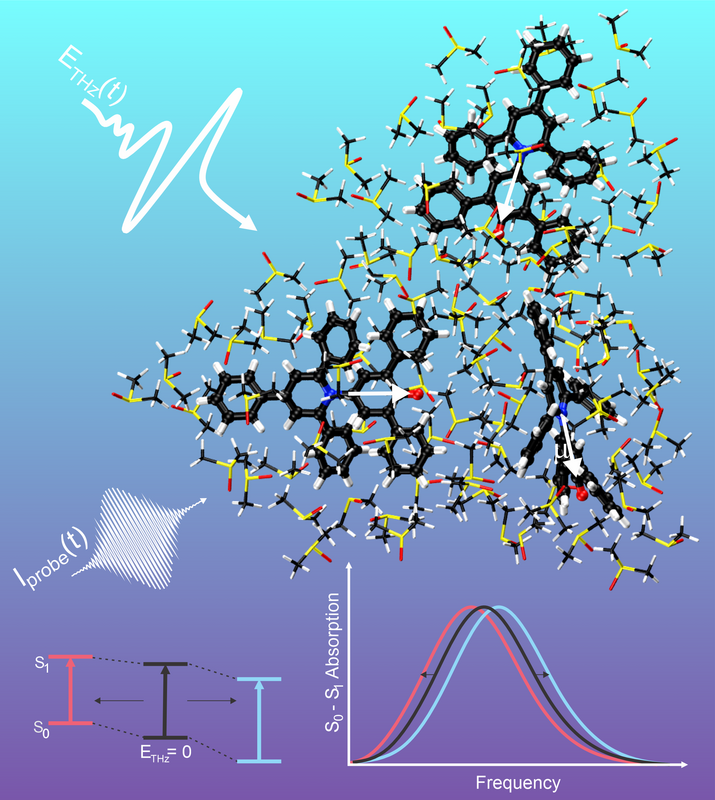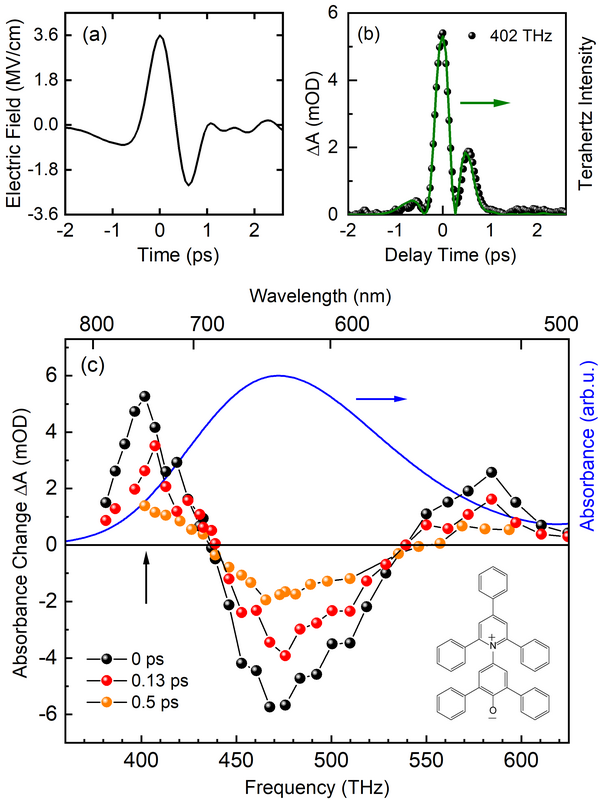A new method maps the optical absorption of molecules in the electric field of an ultrashort terahertz pulse to determine the strength and dynamics of electric interactions.
The spectral shift of optical transitions in an external electric field, the so-called Stark effect, is a fundamental quantum effect in light-matter interaction, giving information on atomic and molecular properties. So far, the Stark effect has mainly been studied under stationary conditions to elucidate the time-averaged behavior of a single quantum system and/or an ensemble. In contrast, time-resolved measurements allow for observing transient properties and give insight in processes on an atomic scale.
Scientists from Max Born Institute in Berlin und Ludwig-Maximilians-Universität in Munich now have used strong electric fields in the terahertz frequency range (1 THz = 1012 Hz) to modify the optical absorption of dye molecules in liquid solution and follow the ultrafast absorption changes in time. They report in The Journal of Physical Chemistry Letters (https://doi.org/10.1021/acs.jpclett.3c01079) that interaction with a THz pulse of a 1-ps duration (1 ps = 10-12 s) broadens the electronic absorption spectrum of the molecules substantially. This transient effect provides quantitative insight in the coupling of the molecules to the external electric field and, at the same time, allows for calibrating the electric field from the solvent. A detailed theoretical analysis shows that the spectral shape of the absorption band is governed by the fluctuating electric forces in the liquid.
In the experiments, an ultrashort THz pulse interacts with a solution of the dye betaine-30 (Fig. 1). The THz electric field acting on the molecules is enhanced with the help of a metallic antenna structure and reaches a maximum value of 3.6 megavolts/cm (MV/cm, Fig. 2a), corresponding to approximately one third of the fluctuating field from the solvent. The momentary change of molecular absorption is monitored by probe pulses of a 100-fs duration. The time evolution is recorded by changing the delay between the two pulses.
The time evolution of the THz electric field is shown in Fig. 2a, the time dependent THz intensity in Fig. 2b (solid line). In Fig. 2c, the absorption change of the dye solution (symbols) is plotted as a function of frequency (bottom abscissa scale) and wavelength (upper abscissa scale). The solid blue line represents the stationary absorption spectrum in absence of a THz field. The transient absorption decrease in the center of the stationary spectrum and the absorption increase on the low- and high-frequency wings correspond to a transient spectral broadening, induced by the THz electric field. In time, this broadening follows the THz intensity (Fig. 2b, symbols), while a contribution of the solvent to the absorption changes is absent. On the ultrashort time scale of the measurement, the solvent is structurally 'frozen'.
In the liquid solution, there exists a disordered ensemble of dye molecules, each molecule possessing a permanent electric dipole moment (Fig. 1). The interaction of such dipoles with the THz electric field shifts the electronic transition between the ground state S0 and the first excited state S1 in frequency (level scheme in Fig. 1). The interaction strength and, thus, the sign and amount of spectral shift are determined by the projection of the THz field onto the direction of molecular dipole moment. As a result, the transient spectra in Fig. 2c reflect the orientally averaged behavior of the dye molecules. A quantitative analysis of the spectral broadening gives the electric coupling strengths and allows for an experimental calibration of the electric fields in the solution. Beyond this basic insight, the ultrafast and fully reversible character of the field-induced absorption changes may lead to applications in optical switches and modulators.



